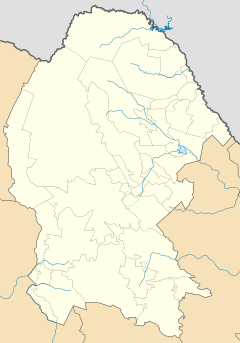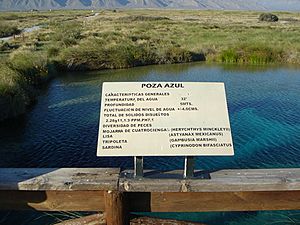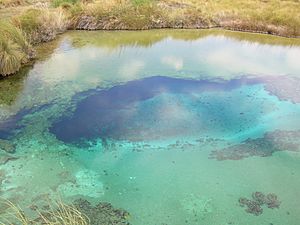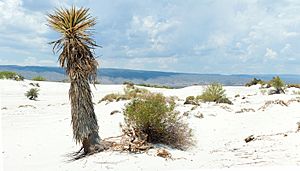Cuatro Ciénegas facts for kids
Quick facts for kids
Cuatro Ciénegas
|
|
|---|---|
|
City
|
|
| Cuatro Ciénegas de Carranza | |
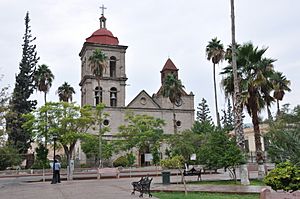
Saint Joseph Parish
|
|
| Country | |
| State | Coahuila |
| Municipality | Cuatrociénegas |
| Founded | 1800 |
Cuatro Ciénegas is a special city in the northern Mexican state of Coahuila. It sits in a desert area, about 740 meters (2,428 feet) above sea level. The name "Cuatro Ciénegas" means "four marshes" in Spanish. This name was chosen by the first people who settled here because of the many natural springs that create wetlands and lakes.
People have lived in this area for a very long time, possibly as far back as 5,000 years ago! The town was officially founded on May 24, 1800, by Antonio Cordero y Bustamante. Over time, its name changed a few times before becoming Cuatro Ciénegas.
Today, the city is formally known as Cuatro Ciénegas de Carranza. This is to honor Venustiano Carranza, a very important person who was born here in 1859. He later became the President of Mexico from 1915 to 1920.
Contents
Discovering Cuatro Ciénegas Basin
|
Designations
|
|
| Official name: Área de Protección de Flora y Fauna Cuatrociénegas | |
| Designated: | 22 June 1995 |
|---|---|
| Reference #: | 734 |
The Cuatro Ciénegas Basin (CCB) is a protected nature reserve in Mexico. It's a unique place because water flows into it from nearby rivers and streams, but it has no natural way for the water to flow out. This creates a special ecosystem.
Scientists are very interested in the Cuatro Ciénegas Basin. NASA even thinks it could help us learn about life on Mars! This is because the plants and animals here have adapted in amazing ways to their environment. There are about 150 different kinds of plants and animals that are found only in this valley and its surrounding mountains.
Unique Life Forms in the Basin
The reserve is home to many special aquatic animals. These include three types of turtles found nowhere else: the Coahuilan box turtle, the Cuatro Ciénegas slider, and the Cuatro Cienegas softshell. There are also eight unique fish species, like Minckley's cichlid and the Bolson pupfish. Many special crustaceans and snails also live here.
One of the most incredible things in Cuatro Ciénegas are the living stromatolites. These are like ancient living rocks, formed by tiny organisms called cyanobacteria. Stromatolites were very common over 3 billion years ago and helped create the oxygen in Earth's atmosphere. They are now rare in most parts of the world, making their presence here very special. A tiny crustacean, Leptocaris stromatolicolus, lives only within these stromatolites and the sandy bottom of the pools.
The water in these pools has very little phosphate, which is a nutrient many living things need. Because of this, a local type of bacteria, Bacillus coahuilensis, has learned to change its cell membranes to use different chemicals. This shows how adaptable life in Cuatro Ciénegas is!
Protecting the Basin
Many groups are working to protect this amazing valley. One organization, Pronatura Noreste, owns a private reserve called Pozas Azules. They have projects to protect native species like stromatolites and remove plants and animals that don't belong there. They also help the local community learn about water-saving farming methods.
Fun Places to Visit
Cuatro Ciénegas has many beautiful natural places that tourists love to visit. These include white sand dunes and unique wetlands.
Poza Azul
Poza Azul is a protected wetland about 9 kilometers (5.6 miles) from the city. It's one of the most famous wetlands in the area. You can see photos of the local plants and animals, walk on viewing platforms, and follow self-guided trails.
La Poza de la Becerra
This pool, whose name means "The Pool of the Calf," is about 16 kilometers (10 miles) from the city. It's part of the Cuatro Ciénegas biosphere reserve and is home to many unique species.
Poza Churince
Poza Churince is located about 18 kilometers (11 miles) from the city. It's an area with spring waters that have different temperatures.
White Dunes
These "Las Dunas de Yeso" (Gypsum Dunes) are a huge area of white sand made of calcium sulfate. They are considered the largest gypsum dunes in Mexico and the third largest in the Americas!
Other Attractions
Other wetlands you can visit include "Nogalito" and "La Ilusión" ecotourism park. There are also resorts like El Entronque and El Mesquite. The Sierra de la Campana mountain range, with its large crater called El hundido, is also a popular spot.
Cuatro Ciénegas is also known for making wine! The winery Bodegas Ferrino, started by an Italian immigrant, is one of the biggest wine producers in Coahuila. Visitors can take tours to learn about how wine is made and explore the beautiful Cuatro Ciénegas valley.
Why Water is Important Here
Scientists and local people have noticed that the amount of water in the springs and surface pools of the Cuatro Ciénegas Basin has been decreasing. This is a concern because the unique ecosystem depends on this water.
Some people think climate change might be causing this, while others believe it's due to large farms in nearby valleys that use a lot of water.
Researchers like Valeria Souza from the National Autonomous University of Mexico have studied the microbes (tiny living things) in the area. Her work suggests that the underground water source (aquifer) that feeds Cuatro Ciénegas is much larger than previously thought and extends into neighboring valleys. This means that water use in those valleys can affect Cuatro Ciénegas. Protecting this water source is very important for the future of this special place.
Climate in Cuatro Ciénegas
| Climate data for Cuatro Ciénegas | |||||||||||||
|---|---|---|---|---|---|---|---|---|---|---|---|---|---|
| Month | Jan | Feb | Mar | Apr | May | Jun | Jul | Aug | Sep | Oct | Nov | Dec | Year |
| Mean daily maximum °C (°F) | 20 (68) |
22.4 (72.3) |
26.8 (80.2) |
31.0 (87.8) |
33.8 (92.8) |
34.8 (94.6) |
34.7 (94.5) |
34.4 (93.9) |
31.7 (89.1) |
28.4 (83.1) |
24 (75) |
20.2 (68.4) |
28.5 (83.3) |
| Mean daily minimum °C (°F) | 4.8 (40.6) |
6.7 (44.1) |
10.6 (51.1) |
15.3 (59.5) |
19.3 (66.7) |
22.0 (71.6) |
22.5 (72.5) |
22.4 (72.3) |
19.9 (67.8) |
15.1 (59.2) |
9.3 (48.7) |
5.6 (42.1) |
14.5 (58.1) |
| Average precipitation mm (inches) | 10 (0.4) |
7.6 (0.3) |
5.1 (0.2) |
10 (0.4) |
20 (0.8) |
25 (1) |
20 (0.8) |
30 (1.2) |
38 (1.5) |
20 (0.8) |
10 (0.4) |
13 (0.5) |
210 (8.4) |
| Source: Weatherbase | |||||||||||||
Cuatro Ciénegas has a desert climate. This means it gets very hot, especially in the summer months like June, July, and August, when temperatures can reach over 90°F (32°C). Winters are milder, with average highs in the upper 60s°F (around 20°C). The area doesn't get much rain, with the wettest months being September and August.
See also
 In Spanish: Cuatrociénegas de Carranza para niños
In Spanish: Cuatrociénegas de Carranza para niños


